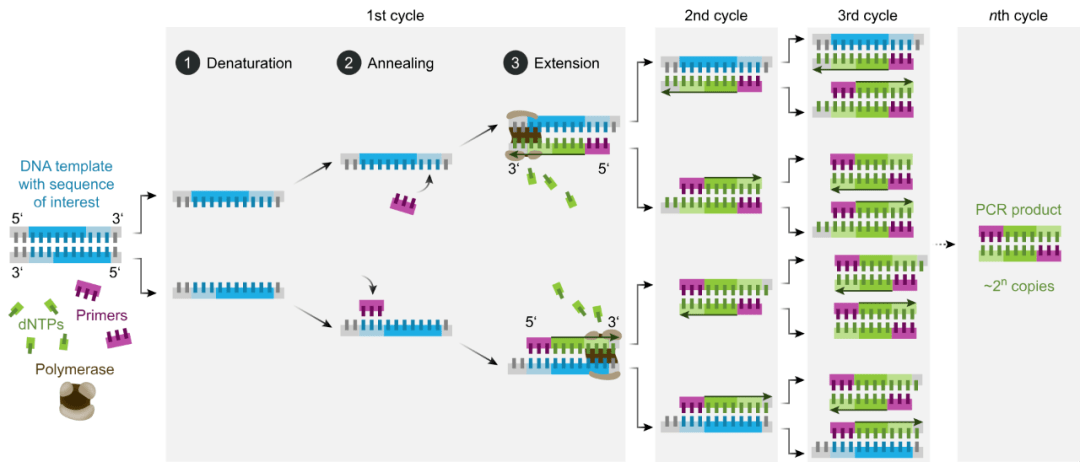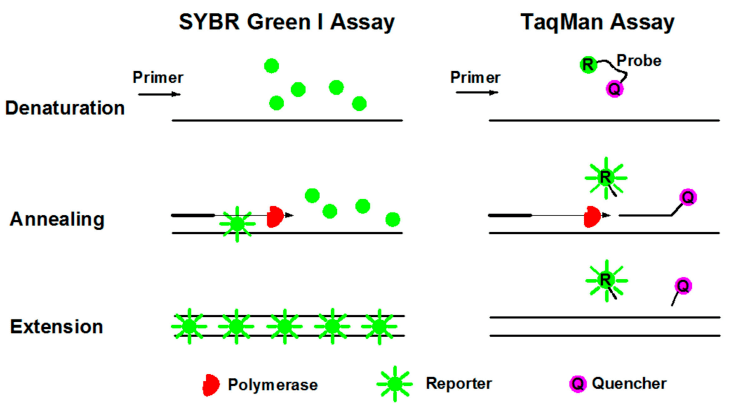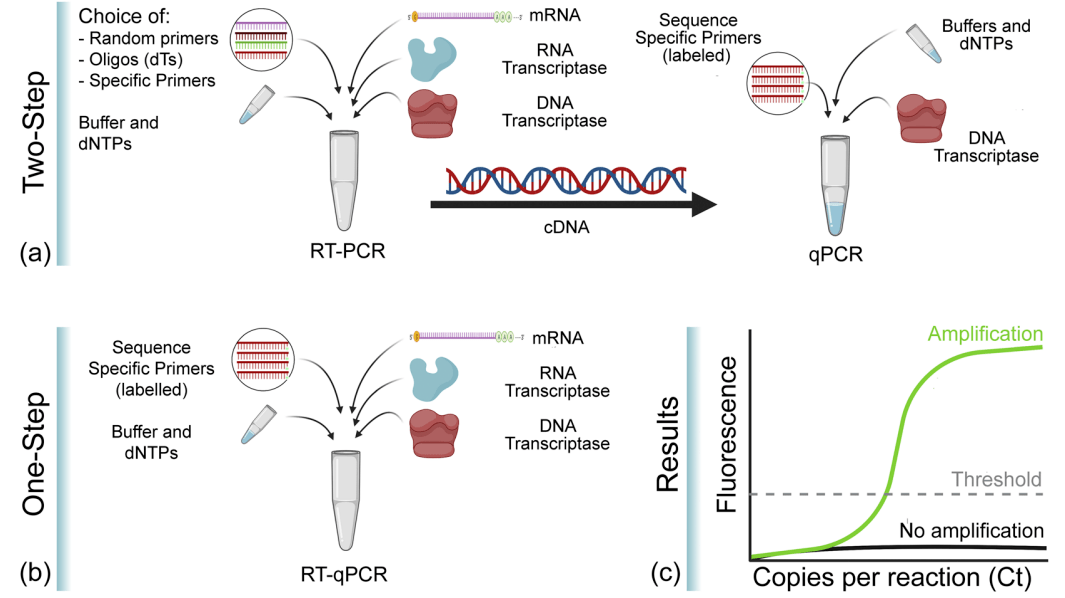
The difference between PCR, qPCR, RT-PCR, RT-qPCR, Real-Time PCR
- Time of issue:2023-03-07
- Views:
(Summary description)Do you know the big family of PCR? Are you still confused?
The difference between PCR, qPCR, RT-PCR, RT-qPCR, Real-Time PCR
(Summary description)Do you know the big family of PCR? Are you still confused?
- Categories:Blogs
- Author:
- Origin:
- Time of issue:2023-03-07 17:02
- Views:
1. What is PCR?
PCR, short for Polymerase Chain Reaction, is a molecular biology technique for in vitro amplification of specific DNA fragments. since its introduction, PCR technology has played a huge role in biological sciences, molecular diagnostics, paternity testing, forensic identification and crime investigation, and is one of the most important technologies to date. Through evolution and innovation, PCR technology has evolved over three generations: ordinary PCR technology, real-time fluorescent quantitative PCR technology (qPCR), and digital PCR (dPCR) technology.

2. Principle of PCR
The basic principle of PCR is similar to the in vivo replication of DNA, and its specificity depends on oligonucleotide primers that are complementary to both ends of the target sequence. PCR consists of three basic reaction steps: denaturation, annealing and extension.
(1) Denaturation of template DNA: the template DNA is heated at high temperature (around 95°C) for a certain time to dissociate it into single strands so that it can bind to the primers.
(2) Annealing (denaturation) of template DNA and primers: when the temperature is lowered to about 55°C, the primers bind to the single strand of template DNA according to the principle of base complementary pairing.
(3) Extension of primers: when the temperature is again adjusted to about 72°C (the optimum reaction temperature for DNA polymerase), the DNA template and primer conjugates are combined under the action of Taq DNA polymerase to synthesize a new semi-conserved replicated strand complementary to the template DNA strand along the direction of phosphate to pentose (5'→3') according to the principle of base pairing and semi-conserved replication. This amplifies the target gene to be amplified several million times after several cycles of denaturation, annealing and extension repeats.

3. Classification of PCR
(1). General PCR
Common PCR is a generation of PCR, using a common PCR amplifier to amplify target genes and qualitative analysis of products by agarose gel electrophoresis.
(2). Quantitative Real-time PCR (qPCR)
Real-time PCR, also known as Real-Time PCR, or second-generation PCR, is a PCR reaction system in which a fluorescent dye or a fluorescent group is added to the PCR amplification system, and the change in the amount of amplified product is monitored in real time during the whole PCR process by collecting fluorescent signals in each cycle, and finally the samples to be tested are quantified by standard curves and CT values. qPCR is commonly used by two methods (a) SYBR Green method and TaqMan probe method.
① Fluorescent dye method (SYBR Green): SYBR Green Ⅰ is the most commonly used fluorescent dye in fluorescent qPCR, which can bind to all double-stranded DNA. When SYBR Green Ⅰ is added to the PCR reaction system, it binds to the double-stranded DNA in the process, thus generating a fluorescent signal. Thus, the total fluorescent signal emitted in the reaction will then be proportional to the amount of double-stranded DNA in the reaction, and the fluorescence intensity will increase as the product increases. However, since the dye binds non-specifically to the double-stranded DNA, a false positive result may be produced.
Advantages: relatively low price; easy to use; no selection of DNA template, good versatility; high detection sensitivity.
Disadvantages: may produce false-positive results; requires melting curve analysis to identify the specificity of the amplified product; requires continuous optimization of the reaction system to reduce non-specific amplification; not suitable for multiplex qPCR assays.
② Fluorescent probe method (TaqMan technology): TaqMan probe is the earliest method used for quantification and is the most commonly used assay in clinical testing. when PCR amplification is performed, a pair of primers is added along with a specific fluorescent probe. The probe is an oligonucleotide labeled with a fluorescent reporter group (Reporter, R) at the 5' end and a quencher group (Quencher, Q) at the 3' end. When the probe is intact, the fluorescence signal emitted by the reporter group is absorbed by the quencher group to the extent that the fluorescence signal cannot be detected; while when the PCR amplifies (during the extension phase), the probe is degraded by the 5'→3' exonuclease activity of Taqase enzyme, so that the reporter group and the quencher group are separated and the fluorescence emitted from the bottom of the reporter group will not be absorbed anymore, thus the fluorescence signal can be received in the fluorescence monitoring system, i.e. every The formation of PCR products is completely synchronized with the formation of fluorescent molecules, and the more PCR products there are, the more fluorescent signals are accumulated and the greater the fluorescence intensity.
Advantages: strong detection specificity; high sensitivity; suitable for multiplex qPCR detection; no subsequent processing of PCR, saving time and raw material costs.
Disadvantages: different probes need to be synthesized according to different sequences; hydrolysis of the probe depends on the activity of Taqase exonuclease, and the quantification is easily affected by the performance of reagents and enzymes; quenching is difficult to be complete, and the background is high; it is difficult to judge the actual amplification characteristics of the assay results.

Note: Multiplex PCR, also known as multiplex primer PCR or compound PCR, is a novel PCR amplification technique in which more than two pairs of primers are added to a reaction system to amplify multiple nucleic acid fragments at the same time.
(3). Digital PCR (Digital PCR, Dig-PCR, dPCR)
Digital PCR, i.e. triple PCR, is another improvement to the original PCR, and is a precise detection technique capable of achieving absolute quantification of nucleic acids. Based on the Poisson distribution principle, nucleic acid samples are distributed into a large number of independent and parallel micro-reaction units (nanoliter) so that there is only one copy or no target DNA molecule in each reaction chamber on average, and then a fluorescent signal is added for amplification, thus achieving target Absolute counting of nucleic acid molecules to improve detection sensitivity and accuracy.
(4). Reverse Transcription PCR (Reverse T ranscription - PCR , RT - PCR)
Reverse transcription PCR, also called reverse transcription PCR, combines reverse transcription (RT) of RNA and polymerase chain amplification of cDNA, and is a widely used variant of PCR. In RT-PCR, a single-stranded RNA is first reverse transcribed into cDNA by reverse transcriptase, and then the cDNA is used as a template to amplify and synthesize the target fragment. The RNA used as a template can be total RNA, mRNA or RNA products transcribed in vitro. Regardless of the type of RNA used, it is critical to ensure that the RNA is free of RNA enzymes and genomic DNA contamination. RT-PCR is a sensitive and widely used technique for detecting gene expression levels in cells, levels of RNA viruses in cells and for direct cloning of cDNA sequences for specific genes. It is generally performed by a one-step or two-step method, where the RT reaction and the PCR reaction are performed in the same tube, while in the two-step method the two reactions are performed separately and sequentially.
(5). Real-time RT-PCR (RT-qPCR)
Real-time RT-PCR is a combination of qPCR and RT-PCR, where "RT" means Reverse transcription, so RT-qPCR is a reverse transcription PCR combined with fluorescence quantification technology, that is, mRNA or total RT-qPCR is a reverse transcription PCR combined with fluorescence quantification, which means that mRNA or total RNA is used as the template to obtain cDNA, and then cDNA is used as the template for quantitative analysis by fluorescence quantification PCR. This is because RT-PCR can only be qualitative, but not quantitative analysis. Like RT-PCR, there are two methods for quantitative analysis of RNA by RT-qPCR: the one-step method and the two-step method. Both methods require reverse transcription of RNA to cDNA before using it as a template for qPCR amplification, except that RT and qPCR in the one-step method are performed in the same test tube, and RT and qPCR in the two-step method are performed separately in sequence.

4. Conclusion
(1). PCR, which usually refers to ordinary PCR, uses double-stranded DNA as template and dNTP as substrate to amplify double-stranded DNA qualitatively.
(2). qPCR and Real-time PCR, which refer to real-time fluorescence quantitative PCR, use cDNA as template and dNTP as substrate to quantitatively analyze the amplified DNA.
(3). RT-PCR, which refers to reverse transcription PCR, uses cDNA reverse transcribed from mRNA as template and dNTP as substrate to amplify DNA, and belongs to the variant of PCR, the results can only be qualitative, not quantitative.
(4). RT-qPCR, referring to real-time fluorescence quantitative reverse transcription PCR, is a combination of qPCR + RT-PCR, in which total RNA or mRNA is reverse transcribed into cDNA and then used as a template, and dNTP is used as a substrate for quantitative analysis by qPCR.
Related news
Shenzhen AIVD Biotechnology Co. , LTD.
A4 Building 4th Floor / B5 Building C501, China Merchants Bright Technology Park, Fenghuang Street, Guangming District, Shenzhen, Guangdong Province, China
E-mail:
market@aivdbiotech.com
info@aivdbiotech.com
Tel: +86-755-26165742 +86 18543132823
WhatsApp:+86 18543132823
© 2022 Shenzhen AIVD Biotechnology Co.,LTD. 粤ICP备18093805号









